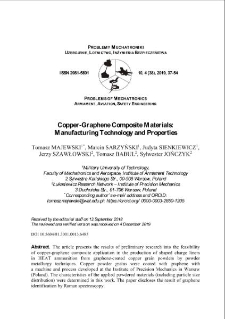Nasza Biblioteka Cyfrowa udostępnia 1 868 obiektów cyfrowych
Obiekt
Tytuł: Copper-Graphene Composite Materials: Manufacturing Technology and Properties ; Copper-Graphene Composite Materials: Manufacturing Technology and Properties
Tytuł odmienny:
Kompozyty miedź-grafen: technologia i właściwości ; Kompozyty miedź-grafen: technologia i właściwości
Współtwórca:
Marcin SARZYŃSKI, Judyta SIENKIEWICZ, Jerzy SZAWŁOWSKI, Tomasz BABUL, Sylwester JOŃCZYK ; Marcin SARZYŃSKI, Judyta SIENKIEWICZ, Jerzy SZAWŁOWSKI, Tomasz BABUL, Sylwester JOŃCZYK
Abstrakt:
The article presents the results of preliminary research into the feasibility of copper-graphene composite application in the production of shaped charge liners in HEAT ammunition from graphene-coated copper grain powders by powder metallurgy techniques. Copper powder grains were coated with graphene with a machine and process developed at the Institute of Precision Mechanics in Warsaw (Poland). The characteristics of the applied powdered materials (including particle size distribution) were determined in this work. The paper discloses the result of graphene identification by Raman spectroscopy. The presence of graphene was confirmed in the processed copper powder. The paper discusses the preparation of copper powder by grinding (refinement) and reduction for consolidation. Powder mixtures of pure copper and graphene powder were applied at different component ratios. P/M compacts and sinters (agglomerates) for the test specimens were made from the proposed mixtures by die pressing and sintering in dissociated ammonia gas. Examples of microstructures and selected test results of material properties are shown for the produced sinters. The paper shows a selection of test results for the copper-graphene composites produced by PPS (Pulse Plasma Sintering) from 100% graphene-coated copper powder. The properties of the produced composite materials were determined, including their density, porosity, and a selection of mechanical properties identified by DSI (Depth Sensing Indentation). It was found that the copper-graphene composite met the primary design criteria applied to shaped charged liners for HEAT munitions. In “traditional” powder metallurgy processes, high-density products can be produced if the composite material features a low content of graphene-coated copper powder; PPS, however, makes the production viable with 100% graphene-coated copper powder.
;
The article presents the results of preliminary research into the feasibility of copper-graphene composite application in the production of shaped charge liners in HEAT ammunition from graphene-coated copper grain powders by powder metallurgy techniques. Copper powder grains were coated with graphene with a machine and process developed at the Institute of Precision Mechanics in Warsaw (Poland). The characteristics of the applied powdered materials (including particle size distribution) were determined in this work. The paper discloses the result of graphene identification by Raman spectroscopy. The presence of graphene was confirmed in the processed copper powder. The paper discusses the preparation of copper powder by grinding (refinement) and reduction for consolidation. Powder mixtures of pure copper and graphene powder were applied at different component ratios. P/M compacts and sinters (agglomerates) for the test specimens were made from the proposed mixtures by die pressing and sintering in dissociated ammonia gas. Examples of microstructures and selected test results of material properties are shown for the produced sinters. The paper shows a selection of test results for the copper-graphene composites produced by PPS (Pulse Plasma Sintering) from 100% graphene-coated copper powder. The properties of the produced composite materials were determined, including their density, porosity, and a selection of mechanical properties identified by DSI (Depth Sensing Indentation). It was found that the copper-graphene composite met the primary design criteria applied to shaped charged liners for HEAT munitions. In “traditional” powder metallurgy processes, high-density products can be produced if the composite material features a low content of graphene-coated copper powder; PPS, however, makes the production viable with 100% graphene-coated copper powder.
Miejsce wydania:
Warszawa
;
Warszawa
Wydawca:
Wojskowa Akademia Techniczna ; Wojskowa Akademia Techniczna
Data utworzenia:
Data złożenia:
Data akceptacji:
Data wydania:
Rozmiar:
Identyfikator:
oai:ribes-88.man.poznan.pl:2565
Sygnatura:
DOI 10.5604/01.3001.0013.6485 ; DOI 10.5604/01.3001.0013.6485
ISSN elektroniczny:
ISSN drukowany:
Język:
Właściciel praw:
Wojskowa Akademia Techniczna ; Wojskowa Akademia Techniczna
Strona początkowa:
Strona końcowa:
Tom:
Słowa kluczowe:
powder metallurgy, shaped charge liners, graphene ; powder metallurgy, shaped charge liners, graphene
Kolekcje, do których przypisany jest obiekt:
Data ostatniej modyfikacji:
29 wrz 2025
Data dodania obiektu:
29 wrz 2025
Liczba wyświetleń treści obiektu:
0
Wszystkie dostępne wersje tego obiektu:
https://ribes-88.man.poznan.pl/publication/2877
Wyświetl opis w formacie RDF:
Wyświetl opis w formacie OAI-PMH:
| Nazwa wydania | Data |
|---|---|
| Copper-Graphene Composite Materials: Manufacturing Technology and Properties | 29 wrz 2025 |
Obiekty Podobne
Tomasz MAJEWSKI Andrzej DĘBSKI, Katarzyna LESZCZYŃSKA-SEJDA
Tomasz MAJEWSKI
Tomasz MAJEWSKI Waldemar A. TRZCIŃSKI, Leszek SZYMAŃCZYK
Tomasz MAJEWSKI Wiesław URBANIAK , Szymon PARYSZEWSKI

